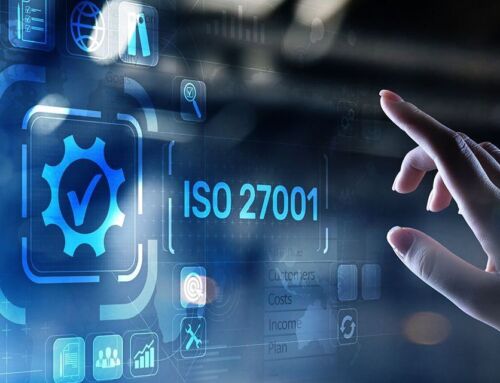Nothing in life really goes according to plan, certainly not in a company with diverse employees and customers. But even though unplanned things can happen, you can still prepare for them – in fact, from a business perspective, you should! Cybersecurity risks in particular are essential for SMEs and large companies. This is where cybersecurity risk management comes into play.

What is Cybersecurity Risk Management?
Risk management of your cybersecurity is an ongoing process in which vulnerabilities in IT are constantly identified, analyzed and evaluated. But remember: this is a job for the entire company, not just the IT department.
Cybersecurity risks are diverse and constantly evolving. As hackers and cyber-attackers become more cunning, you too must become more forearmed. The 6 biggest cybersecurity risks for Swiss SMEs include, for example, the human risk factor, malware and ransomware, or gaps in endpoint security. For example, if your company has been infected with ransomware, you have little time to transfer ransom or consider other ways to save your data and possibly your company’s image.
In order to be optimally prepared for such large but also smaller threats, a well-coordinated IT risk management is required. This is ideally done in 4 steps:
- Identify risks
- Assess risks
- Monitor and control risks
- Continuously monitor and adapt control mechanisms
1. Identify risks
The first goal in risk management is to identify all potential hazards: Which individual risks affect your organization? Where are the biggest weaknesses? What information and systems need special protection? What are the regulatory requirements in your company?
There are some digital risks that particularly affect SMEs. The National Cyber Security Center (NCSC) lists the most frequently reported cyber incidents in Switzerland in its latest figures. At the top of the list are fraud, phishing, and SPAM. Other risks, such as the previously mentioned gaps in endpoint security, should also be included in your analysis. Natural disasters, system failures, and human error are also among the hazards that must be considered, depending on location, level of knowledge, and other factors.
2. Assess risks
Once you have made an as-is analysis of your potential risks and threats, the next step is to analyze and assess them. This involves a quantitative assessment of how likely the corresponding situation is, what impact it would have on your organization, and how extensive this effect would be. Such an internal control system helps you to estimate possible consequences and costs. The IT risk analysis also serves as a guide for subsequent risk management decisions and measures.
3. Monitor and control risks
Once steps one and two are done, the journey is not over. On the contrary, these steps must be constantly repeated. The digital world is changing and with it the potential impact on your organization. Therefore, hazards must be continuously monitored and controlled. Repeat the IT risk analysis at regular intervals, checking whether new material risks or opportunities have been added. In addition to IT risk analyses, risk factors should also be limited. For example, it is a good idea to conduct cybersecurity awareness training with all employees of the company in order to increase know-how throughout the company.
4. Continuously monitor and adapt control mechanisms
To check the cybersecurity risks, one usually uses certain control mechanisms. These must also be regularly checked and adjusted, as changes can also occur here. For example, regulations may be revised, you may be working with new partners, customers or suppliers, or your IT systems may change. According to all such innovations, not only your risk management, but also audit mechanisms need to be adjusted. Also, monitor how effectively your applied risk mitigation procedures are working.
Cyber Risk Management Frameworks
There are different risk management frameworks for IT, which have been established as standards for identifying and mitigating enterprise risks. These can be used to assess and improve the state of your business. Such a framework can help to make the process described above more efficient, and thus make it easier to work out and implement security processes.
We would like to present you a selection of two frameworks here:
NIST CSF
The National Institute of Standards and Technology Cybersecurity Framework (NIST CSF) is a well-known framework for risk management in IT. It provides a variety of best practices and guidelines that help standardize risk management and organize and improve your cybersecurity. NIST CSF thus provides the opportunity to find out how to identify and best respond to cyberattacks.
The framework builds on five categories that form the basis for ranking your IT security.
- Identify
- Protect
- Detect
- Respond
- Recover
It is best to approach this step by step to get complete results. Thus, the Cybersecurity Framework provides NIST with a standard to establish a basic understanding of the need for cybersecurity. In addition, the five functions support you in finding out and gaining control over important components of your infrastructure, your systems and your options, as well as in improving individual areas.
ISO/IEC 27001
ISO/IEC 27001 is the leading international standard for information security management systems (ISMS) and thus the most important cybersecurity certification. Like NIST, it provides clear guidelines for planning, implementing, monitoring, and improving cybersecurity in your organization.
Risk management in IT is a continuous process. This is also the basis for the certified management system according to ISO 27001 – which means that there is a cycle of four steps that should always be repeated: Plan – Do – Check – Act. As in the other frameworks, risks must first be identified, from which requirements and measures are derived, implemented and regularly monitored. After that, improvements should still be recorded steadily.

Best Practices
The preceding explanations already make it clear that there are some best practices when it comes to cybersecurity risk management. We would like to go into more detail on two particularly important ones:
Prioritize Cybersecurity
Realize how important cybersecurity is to the safety of your business. This field should not only be in the hands of the IT department, but should be all-encompassing and relevant for the entire company. At this point, at the latest, it becomes clear that cybersecurity is a matter for the boss, because in the worst case, liability consequences can also fall back on the board of directors. People are still the biggest risk factor, which is why qualified cybersecurity awareness training is just as important as continuous risk analysis.
Continuous Risk Assessments
The threat situation in the digital world is subject to constant change. In addition, safety regulations in your company may also change. For all these reasons, it is advisable to perform risk analyses on an ongoing basis. This includes all the steps listed above: risk identification, assessment, observation and control. This is the only way to identify and eliminate gaps at an early stage.
Not sure where to start in this process? Dinotronic helps! With our Cybersecurity Risk Assessment we work out your personal starting position and analyze your company, your IT infrastructure and all systems individually. From the analysis of the current situation to the development of the target situation and concrete recommendations, we support you in the entire process of your cybersecurity risk management.
Conclusion: Risk management – indispensable?
Times are changing, and digital work is becoming a bigger and bigger issue for SMEs and other companies. Employees are no longer congregating just in the office, but are working in home offices and remotely. These factors make work easier, but they also increase your IT risks. These and other vulnerabilities can be identified and addressed with good cybersecurity risk management. The processes seem costly, but they are worthwhile. And thanks to frameworks like NIST CSF and ISO 27001, as well as a trusted partner like Dinotronic, the process is made much easier for you.



